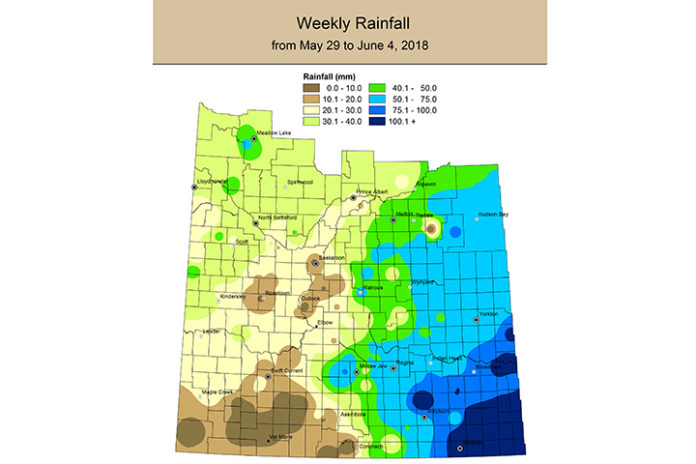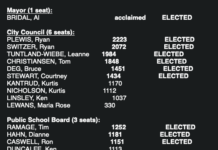Southwest Saskatchewan producers are busy watching the skies for rain clouds to bring some much needed rain.
The Saskatchewan Agriculture Crop Report for the period of May 29 to June 4 notes that crops have been slow to emerge and grow as a result of the low rainfall totals so far this growing season.
Rainfall totals recorded at 26 Southwest locations from April 1 to June 4 measured only between 73.5 millimetres and seven millimetres of precipitation has fallen in the region. That compares to the Lampman region in the Southeast which has recorded a province high 265 millimetres of rainfall this year.
“Although some areas in the region received much-welcomed rain, many areas received nothing and will need significant rainfall in the coming weeks to get crops, pastures and hay growing,” the May 29 to June 4 Crop Report stated about the Southwest. “Concerns remain that if rain is not received soon, soil moisture levels will not be enough to support a crop. Some hay fields have prematurely headed out and crops have been very slow to emerge and grow.”
At current time, Cropland topsoil moisture is rated as 40 per cent adequate, 47 per cent short, and 13 per cent very short. Topsoil moisture conditions on hay land and pasture is rates as 35 per cent adequate, 51 per cent short and 14 per cent very short.
Seeding operations in the Southwest have all but wrapped up, with an estimated 99 per cent of the crop in the ground. Some greened may be seeded if rain is received.
“Crop emergence has been very patchy but some fields will benefit from the recent rain. Pastures and hay land remain dry and in poor condition. The majority of crop damage this past week was due to lack of moisture, strong winds, localized flooding and insects such as flea beetles in canola,” the Crop Report highlighted.
PRECIPITATION TOTALS (April 1 to June 4)
CROP DISTRICT 4A
RM of White Valley #49 – 35 millimetres
RM of Reno #51 – 43 millimetres
RM of Arlington #79 – 21 millimetres
RM of Arlington #79 – 40 millimetres
RM of Carmichael #109 – 25 millimetres
RM of Piapot #110 – 47 millimetres
CROP DISTRICT 4B
RM of Gull Lake #139 (A) – 38 millimetres
RM of Gull Lake #139 (B) – 44 millimetres
RM of Pittville #169 – 34 millimetres
RM of Happyland #231 – 6 millimetres
CROP DISTRICT 3BN
RM of Webb #138 (B) – 73.5 millimetres
RM of Morse #165 – 44 millimetres
RM of Saskatchewan Landing #167 – 33 millimetres
RM of Riverside #168 (A) – 39 millimetres
RM of Riverside #168 (B) – 42 millimetres
RM of Lacadena #228 – 50 millimetres
RM of Monet #257 – 15.5 millimetres
CROP DISTRICT 3BS
RM of Pinto Creek #75 – 33 millimetres
RM of Auvergne #76 – 50 millimetres
RM of Wise Creek #77 – 33 millimetres
RM of Grassy Creek #78 – 46 millimetres
RM of Glenbain #105 – 38 millimetres
RM of Whiska Creek #49 – 49 millimetres
RM of Lac Pelletier #107 – 7 millimetres
RM of Bone Creek #108 – 52 millimetres
RM of Webb #138 (A) – 50 millimetres
* These precipitation amounts represent point locations within each municipality and do not necessarily reflect the whole Rural Municipality






